The Shanghai Auto Show has come to an end. Overall, a noticeable trend at the show was that the product competitiveness of pure electric vehicles has made significant progress. Not less than 10 pure electric vehicles achieved an NEDC range of over 500 km. Among them, Guangzhou Automobile New Energy Aion LX left a particularly deep impression.
Almost Mass-Produced Automobile Aion LX
The basic product parameters of Guangzhou Automobile New Energy Aion LX that have been disclosed are quite limited, but the competitiveness is strong, which is worth further discussion.
What level is it to accelerate from 0 to 100 km/h in 3.9 seconds? Among the globally mass-produced pure electric SUVs, the acceleration of Aion LX ranks second, with the first being 2.9 seconds of Model X P100D. Guangzhou Automobile New Energy has not disclosed more information about the motor, but this result requires a relatively high-power motor, whether it is a permanent magnet or an induction motor.
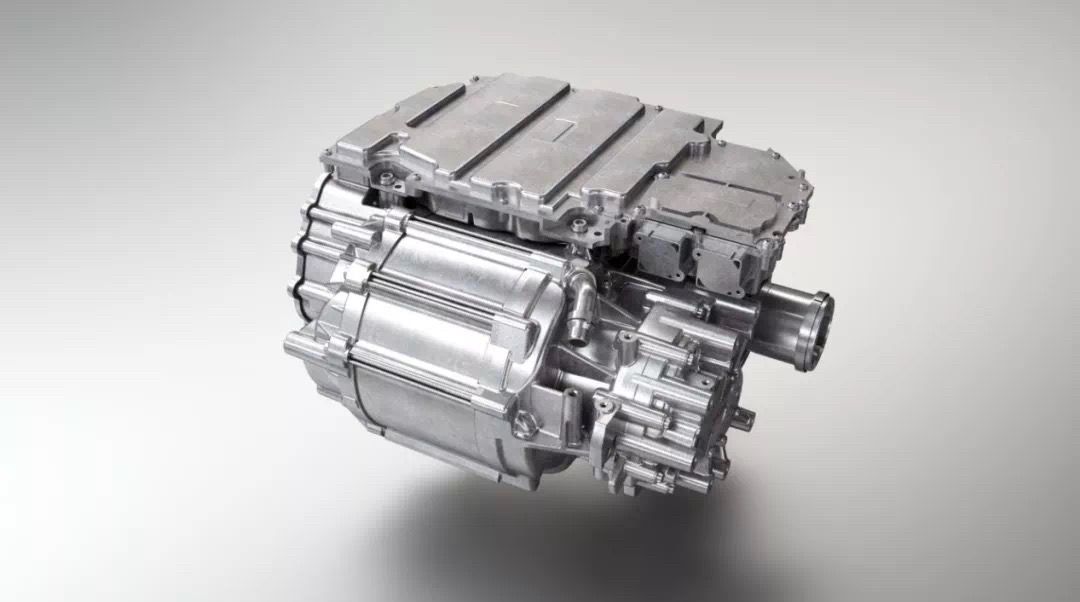
Generally speaking, it is difficult to balance high performance and long range, because the energy consumption performance of the induction motor that can sustain high-power output is relatively poor. Meanwhile, the permanent magnet motor that has good energy consumption performance will have weaker performance in high-power output such as acceleration. However, the NEDC range of Aion LX reaches 600 km, so what level is that?
Tesla Model X 100D has an NEDC range of 575 km, which is the longest pure electric SUV range in the world. However, Model X is a large seven-seat SUV that is much larger than Aion LX. In the mid-size SUV market, which Aion LX focuses on, its NEDC range ranks first in the world.
There is a modifier here, “globally mass-produced pure electric SUVs.” Is it cheating to compare unreleased Aion LX with them?
According to the official statement of Guangzhou Automobile New Energy, Aion LX will be put into production in September of this year. Today is April 24th. Within the next five months, will there be another pure electric SUV that has an NEDC range of 600 km and an acceleration of 3.x seconds per 100 km? It is not entirely impossible, but the probability is very low.
This is why I said that Aion LX leaves a deep impression because it is an almost mass-produced automobile with outstanding product competitiveness, which is fundamentally different from a concept car.
Gasoline Engine Platform? Pure Electric Platform?
One point that has not been mentioned before is the 2900 mm wheelbase, which we can make a horizontal comparison.
Elon Musk was once asked by a netizen whether there would be a planning of Model 3 100D. Elon Musk’s response was that the available capacity of the 75kWh battery pack is the limit of Model 3 due to the constraints of the wheelbase.
By partially stacking dual layers, pure electric vehicles can accommodate larger battery pack specifications. The Audi e-tron shown in the figure is an example. However, if you use a flat plate battery pack that is spread on the bottom of the chassis (also the most mainstream route), the wheelbase length largely determines the upper limit of the battery pack specifications.
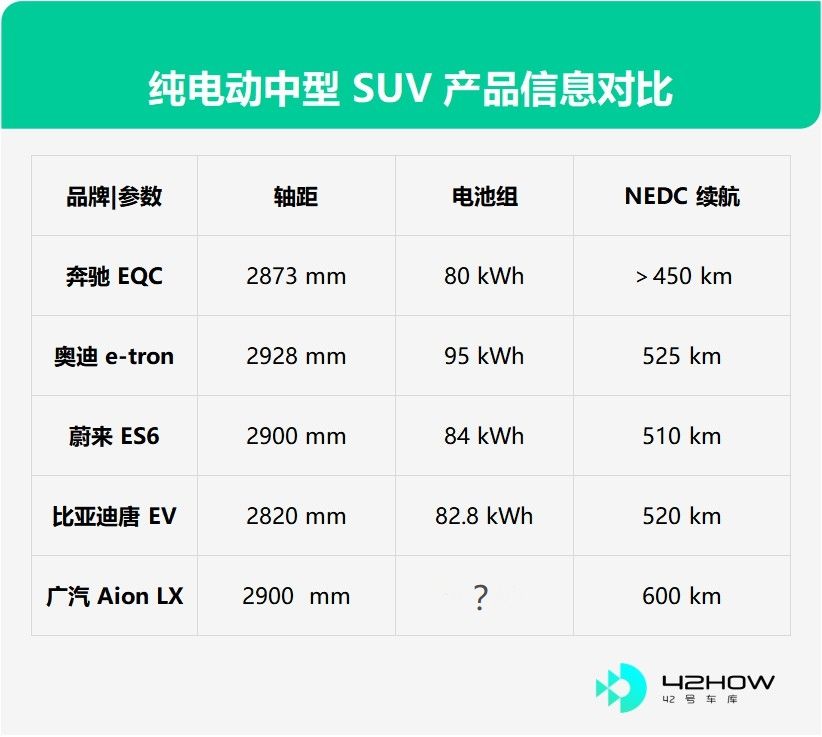
Then let’s look at the figure above. Except for the BYD Tang EV, the wheelbase of other models is around 2900mm, but the differences in cruising range under the same working conditions are huge. Except for the Aion LX, the same-level cruising champion is the Audi e-tron, which achieves a cruising range of 525 km under NEDC, but the battery pack has also been pushed to 95 kWh. So how big does the battery pack of the Aion LX need to be?
Of course, cruising range is closely related to the battery pack specifications, but not the only determining factor. Below we will discuss the importance of platforms in more detail.
-
Mercedes EQC, the same platform as GLC, based on the EVA platform
-
Audi e-tron, the same platform as Q5, based on the MLP platform
-
NIO ES6, the same platform as ES8, based on the pure electric platform
-
BYD Tang EV, the same platform as Tang DM, based on the BLP platform
-
GAC Aion LX, the same platform as Aion S, based on the pure electric platform
First, let’s talk about the Mercedes-Benz and Audi series. The EVA platform, which stands for Electric Vehicle Architecture, is modified from the Mercedes-Benz MRA platform. What is the MRA platform? Mercedes Rear Wheel Drive Architecture, a Mercedes-Benz rear-wheel drive platform, but the EQC is a full-drive model. The name MRA itself reveals a strong gasoline-powered car platform atmosphere. The following is a schematic diagram of the three-electric layout of the EVA platform.
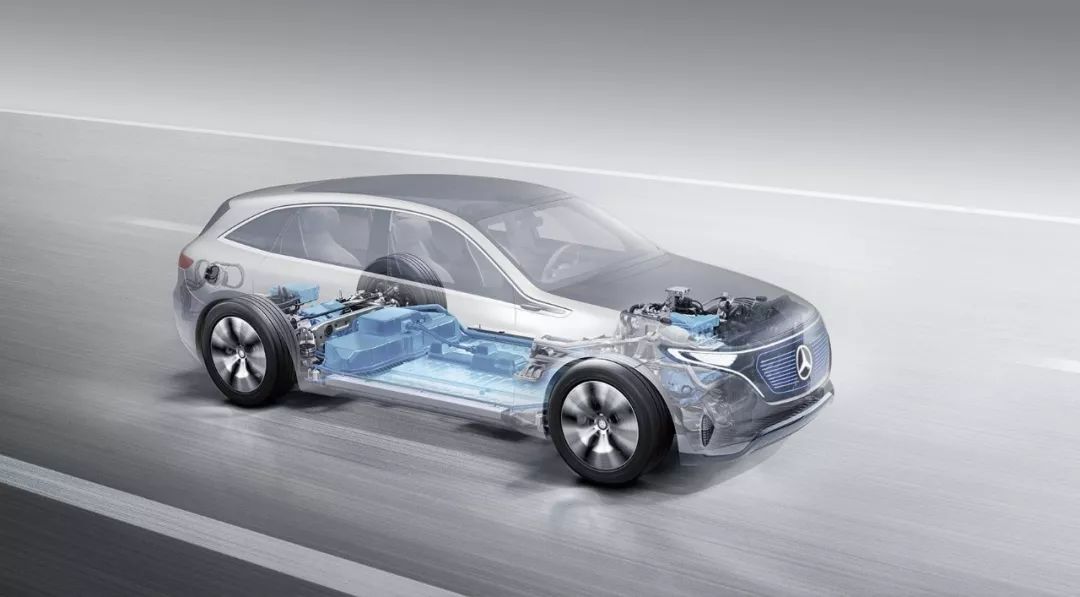
As you can see, the platform that was originally used to arrange the three major components of the internal combustion engine is restricted everywhere when used to arrange the three electric powertrains. For example, there are irregular protrusions under the rear seat, and the space layout of the vehicle’s front is also very complicated.Audi is the same, with the MLP platform, which stands for Modular Longitudinal Platform, an Audi longitudinal modular platform. How could a electric powertrain be planned vertically instead of horizontally? It is nothing but another purely electric model based on the internal combustion engine platform. As mentioned earlier, thanks to the double-layer battery pack under the rear seats, the e-tron has a battery pack capacity of 95 kWh. However, the collapse of the vehicle’s weight did not reflect the high-standard battery pack’s range.
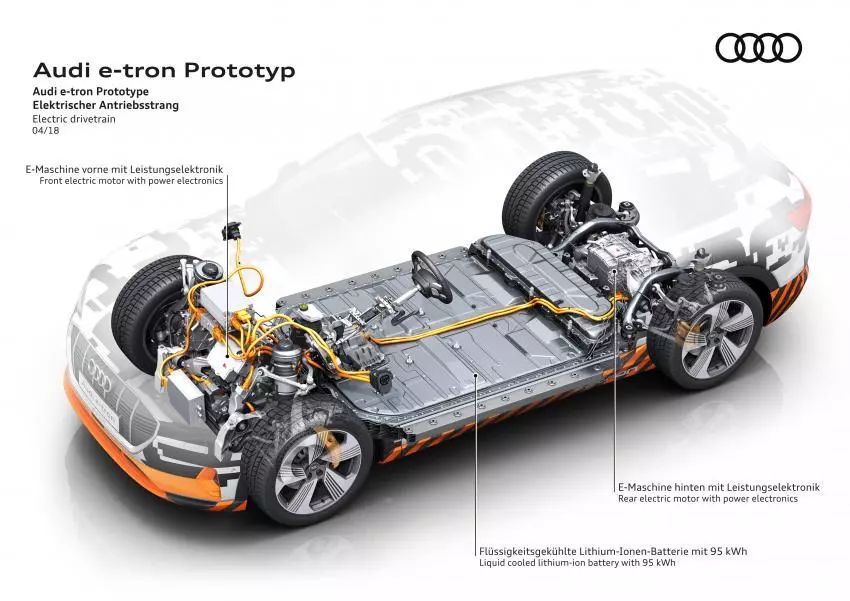
In addition to the EQC and e-tron, there are many pure-electric vehicles developed based on internal combustion engine platforms, but overall, we have not seen a pure-electric vehicle with strong product power.
Now let’s take a look at the pure electric platform of NIO ES6. Below is the platform diagram of NIO ES6, as you can see, the motor, electronics, and battery pack are arranged very reasonably throughout the entire platform. The combination of high-performance motors and long endurance battery pack specifications maximize space utilization.
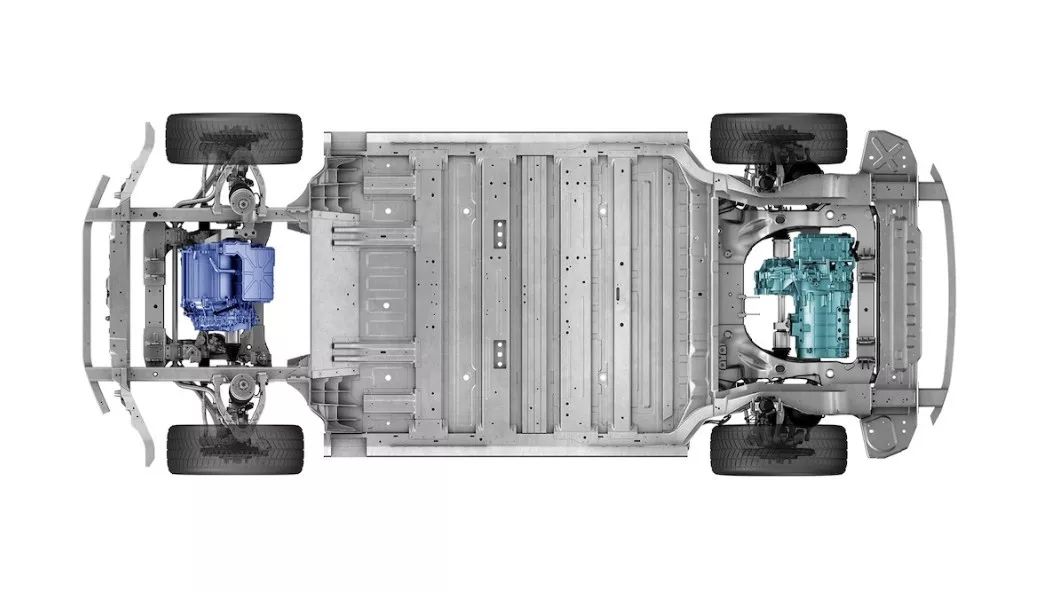
GAC Aion LX is based on GAC’s second-generation pure electric platform GEP, which stands for GAC Electric Platform. GAC New Energy unveiled the platform architecture of Aion LX at the Shanghai Auto Show, and the layout of the high-performance powertrain is very compact.
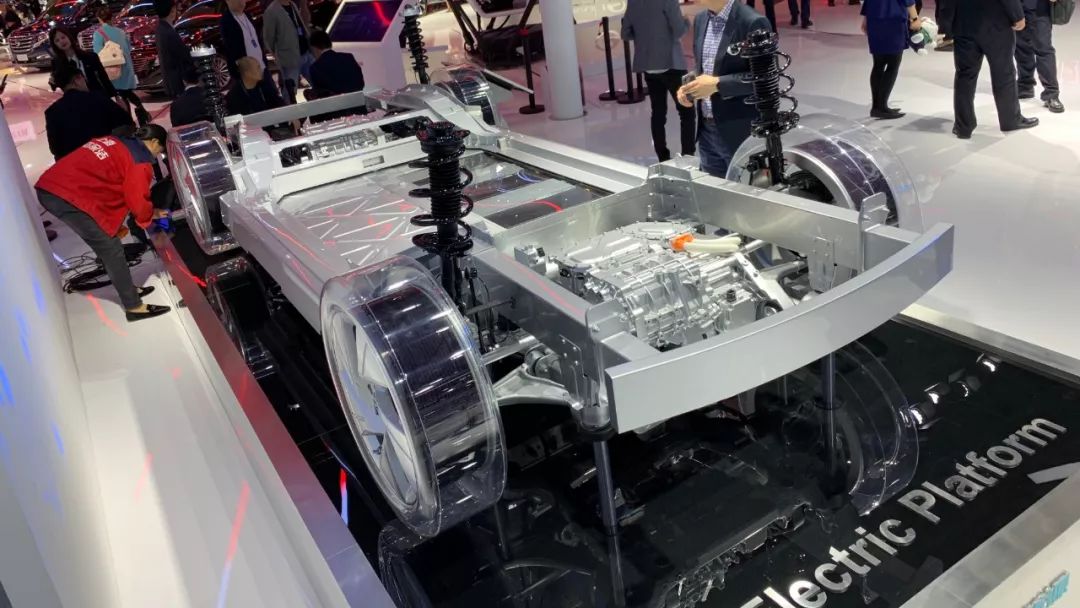

GAC New Energy GEP?
When comparing NIO ES6 and Aion LX, it can be found that based on the same wheelbase, GAC New Energy has surpassed NIO in terms of motor performance and NEDC cruising range. Considering that NIO itself is based on a forward-looking development of pure electric platforms and has never been too hesitant to use advanced technologies, such as high-energy-density batteries and all-aluminum bodies. GAC New Energy’s Aion LX is more worthy of discussion.
As mentioned earlier, GEP is GAC New Energy’s second-generation pure electric platform. The first generation model was launched in 2017, and the representative model was the famous GE3.Compared to others, GEP is a truly forward-looking pure electric platform. During the media communication meeting, GAC put forward a viewpoint called “Only an exclusive platform can maximize the advantages of pure electric vehicles”.
GEP is centered around “battery+electric drive” layout, integrating a three-in-one integrated electric drive system and a new generation of high-density and high-safety ternary lithium batteries.
The so-called three-in-one means integrating motor, electric control, and differential into one unit. The integration and miniaturization of the electric drive assembly is a general trend in the entire industry. Tesla Model 3 and BMW i4, which will be launched in 2020, both use the 5th generation electric drive assembly, which is also a three-in-one system.
High-energy-density batteries, of course, refer to CATL’s 811 battery formula with an energy density of 170-180Wh/kg, combined with GAC’s ASIL C level-compliant BMS and integrated intelligent temperature control system. Here, integration means using the motor’s heat to warm the battery pack. I wonder what the difference is between this and the Model 3’s Superbottle motor stall heating method.
Overall, without the constraint of a battery-swapping structure like the ES6, Aion LX maximizes the use of spatial layout, achieving the second best 0-100km/h acceleration in the whole industry and the longest NEDC range.
In addition to the new platform, from the first mass-produced car Aion S based on the GEP platform, it can be seen that GAC has also done very well in lightweight and aerodynamic design. The high-end version of Aion S has a curb weight of only 1625 kg, and the drag coefficient is as low as 0.245 Cd, both ranking the top tier among the same level competitors. I believe these successful experiences will also be inherited in Aion LX.
Overall, Aion LX is a product that integrates platform, three-electric, design, and lightweight development. Before it, Tesla Model 3 and NIO ES6 were also products that benefited from overall optimization and collective efforts, but Aion LX has pushed this direction to a relatively extreme level. This makes people have even higher expectations for the product details of Aion LX.
Let us wait for the start of production in September and expect GAC New Energy to release more product details of Aion LX.

-
What’s your opinion? Guangzhou Automobile Electric Vehicle Co., Ltd. Aion LX NEDC endurance 600km
-
The new generation of BYD Tang is on the market. Here are 12 things you need to know


This article is a translation by ChatGPT of a Chinese report from 42HOW. If you have any questions about it, please email bd@42how.com.
